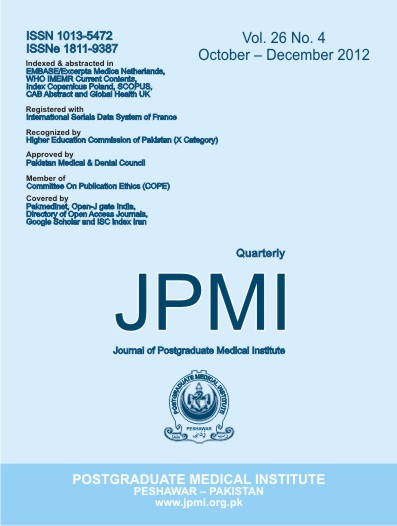FREQUENCY OF ASPIRIN RESISTANCE IN PATIENTS WITH CARDIOVASCULAR DISEASES
Main Article Content
Abstract
Objectives: To find out the frequency of aspirin resistance, as measured by the inhibition of platelet aggregation, using Whole Blood Aggregometery, in patients with cardiovascular diseases presenting to out patient department of a tertiary care hospital.
Methodology: This study was conducted in the outpatient department of Cardiology, Lady Reading Hospital Peshawar, from October 2007 to January 2008. A total of 105 normal individuals not taking aspirin and 136 patients taking aspirin for cardiovascular diseases were randomly included. Blood was taken for measuring platelet aggregation using whole blood aggregometer. Result of each individual was
noted on a proforma . Patients who were on any other ante-platelet like clopidogrel; or on warfarin and heparin were excluded from the study. Chi –square and independent t-test were used to find significant differences between different groups and variables.
Results: Platelet aggregability in 105 normal subjects, not taking aspirin was 9.28±3.23ohms. So cutoff for aspirin non responsiveness was taken as 9.28-3.23=6.0 ohms. Mean aggregability of 136 cardiovascular patient, taking aspirin was 5.81± 5.47 ohms. Mean age was 52.66± 10 years.Male were 80(58.8%). Patients having aggregability ≥ 6 ohms were 47.1%(n=64). Mean aggregability of male patients was 5.66± 5.45 ohms. Mean aggregability of female patients was 6.03 ± 5.54 ohms(p=0.69). When age was correlated with aggregability, both have a weak negative correlation (Pearson correlation coefficient= -.109 (p=0.205). Mean age of patients having aggregability ≤ 5 was 53.73± 9.73 and aggregability ≥ 6 was 51.46 ± 10.36 (p=0.19).
Conclusion: Aspirin resistance as defined by inhibition of platelet aggregation measured with Whole Blood Aggregometry, is a common problem. Gender and age has no significant affect on platelet aggregability.
Methodology: This study was conducted in the outpatient department of Cardiology, Lady Reading Hospital Peshawar, from October 2007 to January 2008. A total of 105 normal individuals not taking aspirin and 136 patients taking aspirin for cardiovascular diseases were randomly included. Blood was taken for measuring platelet aggregation using whole blood aggregometer. Result of each individual was
noted on a proforma . Patients who were on any other ante-platelet like clopidogrel; or on warfarin and heparin were excluded from the study. Chi –square and independent t-test were used to find significant differences between different groups and variables.
Results: Platelet aggregability in 105 normal subjects, not taking aspirin was 9.28±3.23ohms. So cutoff for aspirin non responsiveness was taken as 9.28-3.23=6.0 ohms. Mean aggregability of 136 cardiovascular patient, taking aspirin was 5.81± 5.47 ohms. Mean age was 52.66± 10 years.Male were 80(58.8%). Patients having aggregability ≥ 6 ohms were 47.1%(n=64). Mean aggregability of male patients was 5.66± 5.45 ohms. Mean aggregability of female patients was 6.03 ± 5.54 ohms(p=0.69). When age was correlated with aggregability, both have a weak negative correlation (Pearson correlation coefficient= -.109 (p=0.205). Mean age of patients having aggregability ≤ 5 was 53.73± 9.73 and aggregability ≥ 6 was 51.46 ± 10.36 (p=0.19).
Conclusion: Aspirin resistance as defined by inhibition of platelet aggregation measured with Whole Blood Aggregometry, is a common problem. Gender and age has no significant affect on platelet aggregability.
Article Details
How to Cite
1.
Faheem M, Ali J, Shah I, . S, . H, Asghar M, et al. FREQUENCY OF ASPIRIN RESISTANCE IN PATIENTS WITH CARDIOVASCULAR DISEASES. J Postgrad Med Inst [Internet]. 2012 Sep. 24 [cited 2025 Dec. 5];26(4). Available from: https://jpmi.org.pk/index.php/jpmi/article/view/1368
Issue
Section
Original Article
Work published in JPMI is licensed under a
Creative Commons Attribution-NonCommercial 2.0 Generic License.
Authors are permitted and encouraged to post their work online (e.g., in institutional repositories or on their website) prior to and during the submission process, as it can lead to productive exchanges, as well as earlier and greater citation of published work.


